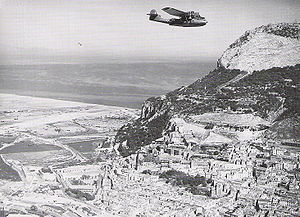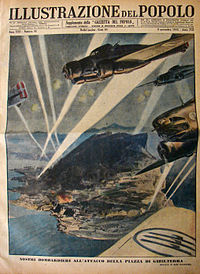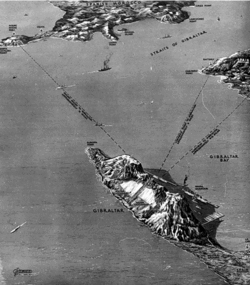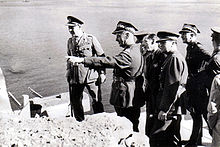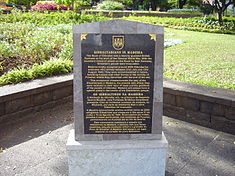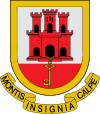- Military history of Gibraltar during World War II
-
- America
- Caribbean
- Gibraltar
- River Plate
- Altmark
- Texel
- SC 7
- HX 84
- HX 106
- Berlin
- Action of 4 April 1941
- Action of 9 May 1941
- Denmark Strait
- Bismarck
- Second Happy Time
- Torpedo Alley
- Action of 27 March 1942
- St. Lawrence
- Action of 6 June 1942
- Laconia
- PQ 17
- Casablanca
- Barents Sea
- Black May
- North Cape
- Operation Stonewall
- Operation Teardrop
- Action of 13 May 1944
- Ushant
- Pierres Noires
- Action of 9 February 1945
- Point Judith
North Africa – East Africa – Mediterranean Sea – Gibraltar – Malta – Dakar – Balkans – Gabon – Iraq – Syria-Lebanon – Madagascar –Bahrain – Palestine – Iran – Italy – Dodecanese – Southern FranceThe military history of Gibraltar during World War II exemplifies Gibraltar's position as a British fortress since the early 18th century and as a vital factor in British military strategy, both as a foothold on the continent of Europe, and as a bastion of British sea power.[1] During World War II, Gibraltar served a vital role in both the Atlantic Theatre and the Mediterranean Theatre, controlling virtually all naval traffic into and out of the Mediterranean Sea from the Atlantic Ocean.[2]
In addition to its commanding position, Gibraltar provided a strongly defended harbour from which ships could operate in both the Atlantic and the Mediterranean. Force H, under the command of Vice-Admiral James Somerville was based in Gibraltar and had the task of maintaining naval superiority and providing a strong escort for convoys to and from the besieged island of Malta.[3] During the course of the war, Gibraltar came under aerial bombardment from Vichy French aircraft and from aircraft of the Italian Royal Air Force (Regia Aeronautica) based on Sardinia. Additionally, the fortress was the focus of underwater attacks by the Italian Royal Navy (Regia Marina) commando frogman unit (Decima Flottiglia MAS) and their human torpedoes. This Italian unit was based on the interned Italian ship SS Olterra in the nearby Spanish harbour of Algeciras.[4] A number of attacks were also carried out by Spanish agents acting on behalf of the German Abwehr.
Inside the Rock of Gibraltar itself, miles of tunnels were excavated from the limestone. Masses of rock were blasted out to build an "underground city".[4] In huge man-made caverns, barracks, offices, and a fully equipped hospital were constructed, complete with an operating theatre and X-ray equipment.[4]
Operation Torch, the Allied invasion of French North Africa in November 1942, was coordinated from the "Rock".[4] General Dwight D. Eisenhower, who was given command of the operation, set up his headquarters in Gibraltar during the planning phases of the operation.[4] Following the successful completion of the North African campaign and the surrender of Italy in 1943, Gibraltar's role shifted from a forward operating base to a rear-area supply position. The harbour continued to operate dry docks and supply depots for the convoy routes through the Mediterranean until V-E Day in 1945.
Prelude and evacuation
Military history of Gibraltar during World War II
• Timeline of events • A Catalina flies by the North Front of the Rock as it leaves Gibraltar on a patrol, 1942 (Imperial War Museum)Late 1939 Construction of a solid surface runway begins in Gibraltar. 9 September 1939 No. 202 Squadron RAF is ordered to Gibraltar. 25 September 1939 No 200 (Coastal) Group is formed as a subordinate
formation to HQ RAF Mediterranean.June 1940 13,500 civilian evacuees are shipped to Casablanca
in French Morocco.13 July 1940 Following the creation of Vichy France,
Gibraltarian civilians are returned to Gibraltar
prior to movement to other locations.July 1940 Evacuees are shipped to the Atlantic island
of Madeira and to London.9 October 1940 1,093 refugees re-evacuated to Jamaica. 10 March 1941 Operation Felix, the German plan for the invasion
of Gibraltar, is amended to become Operation Felix-Heinrich,
which delays the invasion until after the fall of the
Soviet Union, effectively putting an end to
German invasion plans.Late 1941 Plans for Operation Tracer, a stay-behind plan to be put in place
in the event of an invasion of Gibraltar, are formulated.January 1942 Equipment trials for Operation Tracer begin. Mid-1942 Operation Tracer is pronounced ready for deployment. July 1942 Lieutenant General Dwight D. Eisenhower is appointed
Allied Commander-in-Chief of Operation Torch.5 November 1942 Eisenhower arrives in Gibraltar to take command 4 July 1942 A Liberator bomber from RAF Transport Command
takes off from Gibraltar and crashes, killing
Władysław Sikorski, Polish military and political leaderNovember 1943 Resettlement Board established. 6 April 1944 First group of 1,367 repatriates arrives on
Gibraltar directly from the United Kingdom.28 May 1944 First repatriation party leaves Madeira for Gibraltar. 8 May 1945 Victory in Europe Day World War II dramatically changed the lives of Gibraltarians.[5] The decision to enforce mass evacuation in order to increase the strength of the Rock with more military and naval personnel meant that most Gibraltarians (some for up to ten years) had nowhere to call 'home'.[5] Only those civilians with essential jobs were allowed to stay but it gave the entire community a sense of being 'British' by sharing in the war effort.[5]
In early June 1940, about 13,500 evacuees were shipped to Casablanca in French Morocco. However, following the capitulation of the French to the German armies later in June 1940, the new Pro-German French Vichy Government found the presence of Gibraltarian evacuees in Casablanca an embarrassment and sought opportunities for their removal.[5] The opportunity soon arose when 15 British cargo vessels arrived under Commodore Crichton, repatriating 15,000 French servicemen who had been rescued from Dunkirk.[5] Once their own rescued servicemen had disembarked, the ships were interned until they agreed to take away all the evacuees.[5] Although Crichton was unable to obtain permission to clean and restock his ships (and contrary to British Admiralty orders which forbade the taking on of evacuees), when he saw the mass of civilians pouring through the dockyards, he opened up his gangways for boarding.[5] Just recently, the British fleet had destroyed a number of French warships at Mers el-Kebir in order to prevent them ending up in German hands. The attack killed 1,297 French sailors and led to high tensions, which were evident when families were forced at bayonet point by French troops to board taking only what they could carry, leaving many possessions behind. However, when they arrived at Gibraltar, the Governor would not allow them to land, fearing that once the evacuees were back on the Rock, it would be virtually impossible to evacuate them a second time.[6] Crowds gathered in John Macintosh Square in the centre of Gibraltar as the news broke, speeches were made and two City Councillors accompanied by the Acting President of the Exchange and Commercial Library went to see the Governor (Sir Clive Liddell) to ask that the evacuees be allowed to land.[7] After receiving instructions from London, a landing was allowed as long as the evacuees returned when other ships arrived to take them away from the Rock, and by 13 July the re-evacuation back to Gibraltar had been completed.[7]
British conservative politician Oliver Stanley agreed to accept the evacuees in the United Kingdom, but he argued with Gibraltar over the number of people involved.[7] The Governor, he declared, had given the number of evacuees first as 13,000, then as 14,000 and finally as 16,000.[7] He asked for the situation to be clarified, stressing the shortage of accommodation in Britain and insisting that only 13,000 could be accepted, 2,000 of whom were to be sent to the Portuguese Atlantic island of Madeira.[7] The situation, replied General Liddell on 19 July, "is that this is a fortress liable to heave and immediate attack and there should be no civilians here whereas there are 22,000.[7] The 13,000 was the number sent to Morocco, and more would have been sent had the situation there not altered."[7] In London the evacuees were placed in the hands of the Ministry of Health, and many were housed in Kensington area.[7] Concern for them in Gibraltar mounted as the air raids against London intensified, coupled with the arrival of harrowing letters, describing the circumstances in which the evacuees were living.[8]
In September rumours were already circulating among the evacuees, and in Gibraltar, that the possibility of re-evacuating the Gibraltarians once more was being mooted, this time the destination being Jamaica, in the West Indies.[9] After much contention, it was decided to send a party directly from Gibraltar to the island, and 1,093 evacuees left for Jamaica direct, on 9 October, with more following later on.[9] However petitions followed and the demands were met, partly for strategic reasons and the lack of available shipping.[9] The situation at the end of 1940, therefore, was that approximately 2,000 evacuees were in Jamaica and a lesser number in Madeira, with the bulk of around 10,000 housed in the London area.[10]
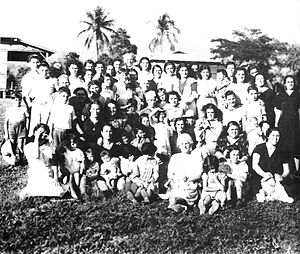 A group of Gibraltarians at the Gibraltar Evacuee Camp in Jamaica during the World War II evacuation.
A group of Gibraltarians at the Gibraltar Evacuee Camp in Jamaica during the World War II evacuation.
Royal Air Force involvement: 1939–1941
Construction of a solid surface runway began in late 1939 and in 1940 it was proposed to extend the existing runway to a length of 1,550 yards (1,417 m).[11] The land reclamation commenced towards the end of 1941 along with the construction of an RAF camp at the "North Front", now RAF Gibraltar.[11] The RAF dispatched their next squadron to Gibraltar at this time and it was in September 1939 that war with Germany was declared and the strong possibility of German submarines concentrating in the Strait of Gibraltar and using Spanish port facilities, loomed large in Admiralty thinking.[11] So at 09:00 (UTC) on the 9 September 1939, No. 202 Squadron RAF was ordered to Gibraltar, loaded to the gunwales with equipment.[11]
On 25 September 1939, No 200 (Coastal) Group was formed as a subordinate formation to HQ RAF Mediterranean in control of No 202 Sqn.[12] The Group's function was the control of Royal Air Force units operating from Gibraltar.[12] In late 1940 the Group was transferred to Coastal Command.[12] Later a combined HQ was formed which commenced operations in early 1942.[11]
Vichy French attacks: 1940
On 18 July 1940, after the destruction of the French Fleet at Mers-el-Kebir by the British, the Vichy government authorized a bombing raid of Gibraltar as a response. Apparently many of the French pilots still found it hard to attack their former ally. The attack was generally half-hearted and most of the bombs were dropped in the sea.[citation needed] Little damage was reported to have been done.
On Tuesday, 24 September, the Italian STEFANI News Agency reported: "As a reprisal for the bombardment of Dakar yesterday morning, one-hundred-and-twenty French aircraft based in Morocco attacked Gibraltar." On the same day, the United Press Agency reported: "The French government has issued an official denial of reports, according to which French aircraft were said to have attacked Gibraltar. Up until now, no reprisals have been undertaken." But the United Press report ended on an ominous note with: "French reprisals are imminent."[13]
Again, on the same day, the Vichy French government issued orders for the naval base and city of Gibraltar to be bombarded. As a result, six bomber squadrons of the Vichy French Air Force (Armée de l'Air de Vichy) and four squadrons of the Vichy French Navy (Marine nationale de Vichy) were employed in the operation. The sixty-four bombers flew from bases in Oran, Tafaroui (in Algeria), Meknes, Mediouna, and Port Lyautey (in Morocco). The French action was approved by both the German Armistice Commission and the Italian Armistice Commission.[14]
No British aircraft were encountered and much damage was done in the area south of the fortress. The South Mole and a large ship in the harbour were heavily damaged. In the northern part of Gibraltar, fires broke out.[14]
On 25 September, the French returned with a larger force of eighty-three bombers to cause additional damages to the naval base and harbour installations. Again, aircraft of the British Royal Air Force made no appearance. However, the French crews did report encountering heavy anti-aircraft fire. One Leo bomber was lost and thirteen other aircraft were lightly damaged during the two days of bombing attacks.[14] The British armed trawler HMT Stella Sirius was sunk by bombs.[15]
The attack on 25 September was to prove to be the last air assault launched against Gibraltar by Vichy forces.
Operation Felix: 1940–1941
For the aerial attack on the harbour of Gibraltar forces are to be designated which will guarantee abundant success. For the subsequent operations against naval objectives and for support of the attack of the Rock mainly dive bombers units are to be transferred to Spain. Sufficient anti-aircraft artillery is to be allocated to the army units including its use against ground targets.[16]
Operation Felix, Directive No. 18, Section IV: Luftwaffe’’ by Adolf Hitler The Rock came through the war relatively unscathed but, given its strategic importance, Germany made plans to capture Gibraltar.[17] Codenamed "Felix", the plan which was signed by Adolf Hitler himself was formulated at the highest level of command.[17] With or without permission, Germany would take entry through Spain and attack Gibraltar driving the British out of the Western Mediterranean.[17] The Strait would be effectively closed to the Allies once Gibraltar was in German hands, forcing Asia-bound Allied shipping to steam all the way around Africa rather than to proceed to the east via the shorter route through the Mediterranean and the Suez Canal.[17] The Rock was to be heavily dive bombed by planes leaving France but landing afterward at Spanish air bases.[17] To deny a possible Spanish capture of the base, the German planners decided that the final attack to seize Gibraltar was to be made by German troops alone.[17]
Diplomatic failure at the highest levels of government prevented the operation from occurring at the beginning of 1941 which had been drawn up in detail by the Wehrmacht in the summer and autumn of 1940.[18]
General Ludwig Kübler's XLIX Corps would conduct the actual attack on the Rock.[18] The assault forces would comprise the Infantry Regiment Großdeutschland, the 98th Regiment of the 1st Mountain Division, 26 medium and heavy artillery battalions, three observation battalions, three engineer battalions, two smoke battalions, a detachment of 150 Brandenburgers, and up to 150 miniature remote controlled demolition vehicles (Goliaths), packed with high explosives.[18]
As part of a combined-force operation, the German Air Force (Luftwaffe) would contribute Ju 88As, Stukas, Messerschmitts, three light AA battalions, and three heavy AA battalions.[17][18] The German Navy (Kriegsmarine) would cooperate by using U-boats to interfere with British naval movement and emplacing coastal batteries to further discourage the Royal Navy.[17][18]
On 10 March 1941, with Operation Barbarossa looming, Felix was amended to Operation Felix-Heinrich,[17] whereby German troops would be withdrawn from the USSR to capture Gibraltar. As a result of Spanish dictator Francisco Franco's intransigence, the operation was postponed, modified, and ultimately abandoned.[17][18]
Italian bombing of Gibraltar
From Sardinia, Italian Piaggio P.108 bombers attacked Gibraltar several times, mainly in 1942. The last raids on Gibraltar were done during the 1943 Allied landing in Algeria, when those bombers hit successfully even the Oran port.
The only unit of the Regia Aeronautica ever to fly the Piaggio P.108 was the "274th Long-Range Bombardment Group".
This unit was formed in May 1941 around the first machines that came off the assembly lines. The training of the crews lasted far longer than anticipated and only in June 1942 the 274th became operational.
The most spectacular raids with the P. 108 bombers were flown in October 1942 when several night attacks against Gibraltar were undertaken from Sardinia.
Italian frogmen raids 1940–1943
Known as the "Floating Trojan Horse of Gibraltar",[19] Decima Flottiglia MAS, an Italian commando frogman unit created during the Fascist government engaged in numerous attacks against the harbour at Gibraltar.
Gibraltar was a very tempting target for the Italians, who saw it as a refuge for British warships and allied merchant shipping.[19] The Italian frogmen originally used a Spanish villa (Villa Carmela) located two miles (3 km) from Gibraltar owned by an Italian officer who had married a Spanish woman named Conchita Ramognino.[19] Their base was shifted later to the Italian tanker SS Olterra, interned in Algeciras.[4]
Date Chronicle of operations of the Decima Flottiglia MAS in Gibraltar August 21, 1940 The Italian submarine Iride left La Spezia (Italy) with plans to attack Gibraltar on 22 August 1940. September 24, 1940 The Italian Submarine Sciré, commanded by Junio Valerio Borghese, left La Spezia carrying three manned torpedoes and eight crewmen. The attack was called off and the submarine ordered back to La Maddalena because the British fleet had left Gibraltar before the Sciré could get into position. October 21, 1940 The Sciré left La Spezia and sailed to Gibraltar carrying three manned torpedoes and eight crewmen. The manned torpedoes entered the harbour, but damaged no ships. Two of the crewmen were captured and the other six escaped to Spain, eventually returning to Italy. The six escapees included Teseo Tesei and Alcide Pedretti. Their manned torpedo later washed ashore at Espigon Bay, and was interned by Spanish authorities. May 25, 1941 The Sciré left La Spezia carrying three manned torpedoes. At Cádiz (Spain), it secretly loaded six crewmen. They found no warships in Gibraltar because HMS Renown, Ark Royal and Sheffield had been ordered into the Atlantic as part of the search for the German battleship Bismarck, which was sunk on May 27. September 10, 1941 The Sciré left La Spezia bearing three manned torpedoes. It secretly loaded six crewmen in Cádiz and sank three ships: two tankers named Denbydale and Fiona Shell, and a cargo ship, the Durham. The crews of the torpedoes swam to Spanish territory after firing their weapons and later returned to Italy. July 1942 Italian frogmen set up a base in the Italian cargo ship Olterra which was interned in Algeciras near Gibraltar. All materials had to be moved secretly through Spain thus limiting operations. July 13, 1942 12 Italian frogmen swam from Villa Carmela into Gibraltar harbour and set explosives, sinking four freighters. December 17, 1942 Six Italians on three torpedoes left the Olterra to attack the British warships HMS Nelson, Formidable, and Furious. A British patrol boat killed one torpedo's crew (Lt. Visintini and Petty Officer Magro) with a depth charge. Their bodies were recovered, and their swimfins were taken and used by two of Gibraltar's British guard divers; Sydney Knowles and Commander Lionel Crabb. A British patrol boat detected another torpedo, and pursued and shot at it, capturing its two crewmen. The remaining torpedo returned to the Olterra, having lost its rear rider. May 8, 1943 Three Italian manned torpedoes left the cargo ship Olterra to attack Gibraltar in bad weather and sank three Allied freighters. August 3, 1943 Three Italian manned torpedoes left the Olterra to attack Gibraltar, and again sank three merchantmen. Spanish saboteurs
Lesser known than the Italian actions were the sabotage operations and limpet-mine attacks carried out by Spanish agents recruited by the Germans. The Abwehr contacted a Spanish staff officer from Campo de Gibraltar, Lieutenant Colonel Eleuterio Sánchez Rubio, to establish a network of saboteurs with access to Gibraltar. Sánchez Rubio designated Emilio Plazas Tejera, a member of Falange, as operations chief of the organisation.[20]
Financed, trained and equipped by the Germans, the saboteurs claimed the sinking of the armed trawler HMT Erin, and the destruction of the auxiliary minesweeper HMT Honjo, which resulted in the deaths of six British seamen on 18 January 1942.[21][22][23] Plazas was assisted by the Spanish naval commander of Puente Mayorga, Manuel Romero Hume, who allowed him to beach a rowboat there. By September 1942, Plazas, whose activities were closely monitored by the British at that time, resigned and left Carlos Calvo, his second in command, in charge of the operations.[20]
In March 1943 an ammunition dump was blown up by Calvo's agents. The British, growing suspicious of some of the saboteurs, banned them from entering Gibraltar. This forced the Abwehr to ask Calvo for new personnel. A Spaniard working on the "Rock", José Martín Muñoz, was responsible for the explosion and fire at a large fuel tank at Coaling island on 30 June 1943; this mission, however, would be the first and the last for Muñoz, because he was cornered and arrested by British authorities in August, and eventually executed on 11 January 1944. A member of an unrelated Abwehr sabotage network, Luis López Cordón-Cuenca, also arrested in 1943, faced the firing squad the same day. Calvo himself was put under arrest by the Spanish police and neutralized. He would be a free man again in December, when he rejoined the Abwehr in Madrid, under direct orders of Wolfgang Blaum, aka Baumann, head of the sabotage section in Spain.[20] After a Falangist attempt against the life of pro-allied General José Enrique Varela, perpetrated by Sánchez Rubio network's agent Juan José Domínguez and a meeting between Anthony Eden and the Spanish ambassador at London, Jacobo Fitz-James Stuart, Abwehr activities around Gibraltar came to an end.[24]
Operation Tracer: 1941–1942
Italian newsmagazine Illustrazione del Popolo front cover depicting the Italian bombardment of Gibraltar. Dated 8 November 1942.
Operation Tracer was a top-secret British stay-behind spying mission that was only to be implemented if Gibraltar was captured by the Axis Powers.[25] Six men were to be sealed in a cave and left with only enough supplies for a year. The volunteers —two doctors, three signalmen and their leader— would run an observation post with two 12-inch (300 mm) by 6-inch (150 mm) slits, one looking due east out over the Mediterranean and the other west over the Strait of Gibraltar and the harbour. The team would then wire back all shipping movements to the British Admiralty.[25]
They were told there would be no way out and anyone who died within the chamber would have to be embalmed and cemented into the walls. Only if Germany was defeated within their first year would they be released.[25]
As the threat of invasion was clearly felt in late 1941, an idea for a series of secret observation posts (first in Gibraltar and later in other places like Malta and Aden) was put together under Operation Tracer.[25]
Work in Gibraltar began immediately under Commander Geoffrey Birley and his chief engineer Colonel Fordham. The site chosen at Lord Airey’s Battery on the southern tip of the Rock already had an existing tunnelling scheme for a shelter.[25] Extensive trials of the equipment began in January 1942 under the eye of MI6 radio expert Colonel Gambier-Parry. Much thought was also given to the type of men needed for such a strange and demanding task.[25] A member of Scott’s ill-fated expedition to the Antarctic, Murray Levick was called up as Surgeon-Commander to advise on survival techniques.[25] There were practical matters such as diet, exercise, sanitation and clothing to consider as well as vital ‘psychology of the personnel’.[25] The full team was in place by the end of summer 1942 and their cavern fully equipped and ready for occupation.[25] A comprehensive manual was prepared on all aspects of the operation and it was considered that similar secret lookout posts should be prepared throughout the world in the event of future wars. However, Operation Tracer was never needed, as Adolf Hitler turned his attention away from Gibraltar and towards the Eastern Front.[25]
The operation had been clouded in mystery until the discovery of papers at the Public Records Office in Kew UK.[25] Previously in the 1960s, details of the story were told to a journalist by his intelligence service contacts and he wrote these up as ‘Operation Monkey,’ yet facts were very sparse.[25]
In 1997 'Stay Behind Cave' (as it was nicknamed) was discovered in Gibraltar by the Gibraltar Caving Group,[26] but no account was ever obtained from anyone associated with the mission.[25] The discovery came about when the group encountered a strong gust of wind in a tunnel. Further searching led them to break through a wall into chambers which had never been used and had remained sealed for over 50 years.[27]
In November 2006 Jim Crone and Sergeant Major Pete Jackson, senior tunnel guide with the Royal Gibraltar Regiment, met possibly the only member of Operation Tracer still alive when they travelled to meet Dr. W. A. Bruce Cooper at his home in England.[25] Cooper, 92 at the time, provided an opportunity to shed light on the operation with his direct involvement in the mission as a Surgeon-Lieutenant in the Royal Navy Volunteer Reserve (RNVR).[25] He recalled stories about his colleagues, his training, and his feelings about the task.[28]
Mediterranean U-boat Campaign: 1941 - 1944
The Mediterranean U-boat Campaign lasted approximately from September 21, 1941, to May 1944. The German Navy (Kriegsmarine) tried to isolate Gibraltar, Malta, and Suez and disrupt Britain's trade routes. More than sixty U-boats were sent to interdict Allied shipping in the Mediterranean Sea. Many of these U-boats were themselves attacked negotiating the Strait of Gibraltar controlled by Britain. Nine U-boats were sunk while attempting passage and ten more were damaged.
North African Campaign: 1942
Plans for the Allied counter offensive after the attack on Pearl Harbor were ongoing by mid-1942.[29] An invasion of Europe in 1943 would be unworkable, but the allies could attack the "soft underbelly of Europe" through the Mediterranean, as Prime Minister Winston Churchill put it.[29] Devised by President Franklin Roosevelt and Churchill and code named Operation Torch, the plan was to occupy French North Africa: Morocco, Algeria, and Tunisia. From these French colonies, attacks could be launched that would drive Italy out of the war.[29]
In July 1942, Lieutenant General Dwight D. Eisenhower[I] was appointed Allied Commander-in-Chief of Operation Torch.[29] Churchill placed Gibraltar under the command of General Eisenhower as the temporary headquarters for this, the first large-scale Anglo-American operation of the war.[29] He arrived in Gibraltar on 5 November 1942 to take over, not just command of Operation Torch itself, but also military command of Gibraltar.[29]
General Eisenhower stayed at The Convent, the official Governor's residence, but his operational headquarters were in a small chamber in a tunnel in the heart of the Rock.[29] In his memoirs General Eisenhower wrote:
The subterranean passages under the Rock provided the sole available office space, and in them was located the signal equipment by which we expected to keep in touch with the commanders of the three assault forces. The eternal darkness of the tunnels was here and there partially pierced by feeble electric bulbs. Damp, cold air in block-long passages was heavy with stagnation and did not noticeably respond to the clattering efforts of electric fans. Through the arched ceilings came a constant drip, drip, drip of surface water that faithfully but drearily ticked off the seconds of the interminable, almost unendurable, wait which always occurs between completion of a military plan and the moment action begins.[29]One hundred thousand soldiers on the high seas in a multitude of transports converged on Gibraltar.[29] More than 400 aircraft of all types were crammed into the dispersal areas around the Gibraltar runway.[30] Fighters had been shipped in crates and assembled on the airfield.[5] Every available area of storage was taken up with ammunition, fuel, and other essential supplies. 168 American pilots were housed in the RAF messes at North Front.[29]
On 8 November 1942, 466 aircraft from Gibraltar landed on captured North African airfields.
From their headquarters in Gibraltar, General Eisenhower and Admiral Sir Andrew Browne Cunningham[III] directed Operation Torch, the first major combined combat operation during World War II involving American and British forces.[29]
War tunnels
Given that Gibraltar was a small town with only a few defences protecting it, the solution was to build a massive series of tunnels and chambers inside the natural protection of the Rock of Gibraltar.[31] This "town" inside the Rock contained its own power station, water supply, and hospital.[31] Some soldiers posted here would not see the light of day for months on end. Two Canadian engineer companies, the only soldiers with diamond-tipped drills and 5 British engineer companies, added some 30 miles (48 km) of such tunnels, a feat thought impossible at the time. That was enough to hold all 30 000 troops on the rock. Today, the rock has more underground tunnels than roads.
Death of Władysław Sikorski: 1943
On 4 July 1943, a Liberator bomber from RAF Transport Command took off from Gibraltar for England.[32] On board was General Władysław Sikorski, Prime Minister of Poland's London-based government in exile and Commander-in-Chief of its armed forces, returning from visiting Polish troops in the Middle East.[32]
The aircraft climbed normally from the runway, levelled off to gather speed but then suddenly lost height and crashed into the harbour.[32] The 62-year-old general died, along with 15 others.[32] The sole survivor was the Czech-born pilot, Max Prchal, who was rescued by an RAF launch.[32] The bodies of five passengers and crew, including Sikorski's daughter, were never found.[32]
The coffins of General Sikorski and his Chief-of-Staff, General Kilimecki, were draped in the Polish National Flag and lay in state in the Cathedral of St. Mary the Crowned.[33] After a Requiem Mass, the bodies were carried in procession to the H.M. Dockyard with full Military Honours to be shipped to London in anticipation that General Sikorski’s remains would one day be returned to a liberated Poland.[33] The route to the dockyard was lined by British troops and the coffins carried and escorted by Polish Servicemen.[33]
Investigation
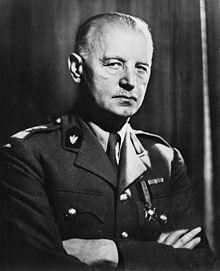 Władysław Sikorski, Prime Minister of Poland, died in Gibraltar after an aviation accident. His death became a cause célèbre and the subject of multiple conspiracy theories.
Władysław Sikorski, Prime Minister of Poland, died in Gibraltar after an aviation accident. His death became a cause célèbre and the subject of multiple conspiracy theories.
In 1943 a British Court of Inquiry investigated the crash of Sikorski's Liberator II AL523, but was unable to determine the probable cause, finding only that it was an accident[34] and the "aircraft became uncontrollable for reasons which cannot be established". A popular theory was insufficient technical maintenance leading to jamming aircraft controls.[35] Despite this finding, the political context of the event, coupled with a variety of curious circumstances, immediately gave rise to speculation that Sikorski's death had been no accident, and may in fact have been the direct result of a Soviet, British or even Polish conspiracy.[36]
Six weeks before the crash, while Sikorski had been at Gibraltar for the first time, en route to his Middle East inspection, a Polish government office in London received a phone call stating that Sikorski had been killed in a crash at Gibraltar; the call had been discounted as a prank, but has since led to speculation. It is often mentioned that two of Sikorski's previous planes had been subject to incidents. The 30 November 1942, forced landing at Montreal, Canada, was suspected to have been caused by sabotage. Another incident might have taken place few months earlier, in March.[36] At Gibraltar, due to the special treatment accorded VIPs, there was uncertainty about who had in fact boarded the plane and about the exact cargo manifest—all leading to uncertainty as to the identity of the bodies recovered from the crash site; some bodies, including that of Sikorski's daughter, Zofia, have never been recovered.[37]
Aftermath
...a matter so fraught with hysteria and heart burning...
Miles Clifford, Colonial Secretary to the Colonial Office. (11 July 1944) The surrender of Italy in September 1943 lifted any possible objections to the return of the evacuees to the Rock.[7] As a result a Resettlement Board was established in November, and at a meeting of the Board on 8 February 1944 repatriation priorities were finally agreed.[7] On 6 April 1944 the first group of 1,367 repatriates arrived on the Rock directly from the United Kingdom and on 28 May, the first repatriation party left Madeira, and by the end of 1944 only 520 non-priority evacuees remained on the island.[7]
In London, home-comers were making claims on the evacuees’ wartime accommodation and 500 Gibraltarians were re-evacuated to Scotland and 3,000 to camps in Northern Ireland.[30] Although the Governor, Lt. General Sir Noel Mason-MacFarlane, fought valiantly on behalf of the evacuees and did not accept the lack of accommodation as a sufficient reason for the delays.[30] As late as 1947 there were still 2,000 in Northern Irish camps.[30] The last of the evacuees did not see the Rock again until 1951.[30]
Notes
I^ Later President of the United States of America.
II^ Originally the Artificer Company during the Great Siege of Gibraltar (1779–1783).
III^ British admiral Andrew Cunningham, 1st Viscount Cunningham of Hyndhope led naval forces in several critical Mediterranean naval battles as Commander-in-Chief. These included the attack on Taranto in 1940, the first carrier-based air attack in history and the Battle of Cape Matapan in 1941.
Citations
- ^ The Rock by Warren Tute, publ. by Companion Book Club,. 1958
- ^ William G.F. Jackson, The Rock of the Gibraltarians. A History of Gibraltar, Grendon : Gibraltar Books (1987) 1998
- ^ "Gibraltar's role in WWII". WW2 People's War. http://www.bbc.co.uk/ww2peopleswar/stories/73/a2683073.shtml. Retrieved 2007-07-31.
- ^ a b c d e f "What life was like on the Rock during the War Years". WW2 People's War. http://www.bbc.co.uk/ww2peopleswar/stories/99/a2627499.shtml. Retrieved 2007-07-31.
- ^ a b c d e f g h Bond, pp. 97
- ^ Bond, pp. 98
- ^ a b c d e f g h i j k Garcia, pp. 15
- ^ GGA, Evacuation 1940: General Mechanics of
- ^ a b c Garcia, pp. 16
- ^ Garcia, pp. 16–17
- ^ a b c d e "The History of RAF Gibraltar". Royal Air Force—Gibraltar. http://www.raf.mod.uk/rafgibraltar/aboutus/hist.cfm. Retrieved 2007-07-05.
- ^ a b c "Air of Authority—A History of RAF Organisation". Royal Air Force Organisation. http://www.rafweb.org/Grp07.htm. Retrieved 2007-07-04.
- ^ Piekałkiewicz. Sea War: 1939-1945. p. 90
- ^ a b c Piekałkiewicz. Sea War: 1939-1945. p. 102
- ^ Naval-History.net
- ^ Prior, Dorothy E. (2005). A short History of Loreto in Gibraltar. Gibraltar: DOMA. ISBN 0-9583016-0-3.
- ^ a b c d e f g h i j Bond pp. 100–102
- ^ a b c d e f "Operation Felix: Assault on Gibraltar". Bill Stone. http://stonebooks.com/history/felix.shtml. Retrieved 2007-08-16.
- ^ a b c "Naval Assault Units". Commando Supremo. http://www.comandosupremo.com/Decima.html. Retrieved 2007-09-04.
- ^ a b c Ros Agudo (2005), pp. 232-234
- ^ Royal Navy casualties, January 1942
- ^ Naval Events, January 1942, Part 2
- ^ HMS Erin ASW Trawler Uboat.net
- ^ Ros Agudo (2005), p. 236
- ^ a b c d e f g h i j k l m n o "Operation Tracer". Gibraltar Magazine. October 1997.
- ^ "STAY BEHIND CAVE – The Unique Finding of a Forgotten Story". Gibraltar Heritage (Gibraltar Government Heritage Division) 1 (1). 2002. Archived from the original on August 19, 2007. http://web.archive.org/web/20070819202831/http://www.gib.gi/museum/HMag+V1+I1+P2.htm. Retrieved 2008-11-07.
- ^ "Operation Tracer—Stay Behind Cave". discoverGibraltar.com. http://www.discovergibraltar.com/mainlogo/mainfrm.htm. Retrieved 2007-07-05.
- ^ "Secret plan to bury soldiers alive inside Rock of Gibraltar". The Belfast Telegraph. 2007-Feb-05. http://www.belfasttelegraph.co.uk/news/local-national/secret-plan-to-bury-soldiers-alive-inside-rock-of-gibraltar-13411081.html. Retrieved 2010-Nov-05.
- ^ a b c d e f g h i j k "Address by the Hon P.R. Caruana QC on the occasion of a plaque unveiling ceremony to commemorate 'Operation Torch'". Government of Gibraltar. http://www.gibraltar.gov.gi/latest_news/topical_speeches/operation_torch.htm. Retrieved 2007-07-01.[dead link]
- ^ a b c d e Bond, pp. 100
- ^ a b "The Great Siege Tunnels". Government of Gibraltar. http://www.gibraltar.gov.gi/tourism/great_siege.htm. Retrieved 2007-06-29.[dead link]
- ^ a b c d e f "Real History and the Death of General Sikorski". The Times. http://www.fpp.co.uk/History/Sikorski/Times040703.html. Retrieved 2007-06-30.
- ^ a b c "General Sikorski". Cathedral of Saint Mary the Crowned.
- ^ Stanczyk, Zbigniew L., "Tajemnica gen. Sikorskiego", Przegląd Polski Online", 7 December 2002, in Polish, retrieved 31 July 2007
- ^ (Polish) Various authors. Biuletyn „Kombatant” nr specjalny (148) czerwiec 2003 Special Edition of Kombatant Bulletin No.148 6/2003 on the occasion of the Year of General Sikorski. Official publication of the Polish government Agency of Combatants and Repressed
- ^ a b "'Polish soldier's 'fishy' sabotage tale'". BBC. 4 September 2006. http://news.bbc.co.uk/1/hi/uk/5307448.stm. Retrieved 2007-06-30.
- ^ (Polish) Baliszewski, Dawid, "Bransoletka Zofii" ("Zofia's Bracelet"), Tygodnik Wprost, no. 1152 (31 December 2004), retrieved 31 July 2007.
References
- Bond, Peter (2003). "The Third Century 1904-2004". 300 Years of British Gibraltar, 1704-2004. Gibraltar: Peter-Tan Publishing Co..
- Garcia, Joseph J (1994). Gibraltar: The making of a people; The modern political history of Gibraltar and its people. Gibraltar: Mediterranean SUN Publishing Co. Ltd.,.
- William G.F. Jackson, The Rock of the Gibraltarians. A History of Gibraltar, Grendon : Gibraltar Books (1987) 1998
- Piekałkiewicz, Janusz (1987). Sea War: 1939-1945. London - New York: Blandford Press. pp. 353. ISBN 0-7137-1665-7.
- Prior, Dorothy E. (2005). A short History of Loreto in Gibraltar. Gibraltar: DOMA. ISBN 0-9583016-0-3.
- Rohwer, Jürgen; Hümmelchen, Gerhard (1992) [1968 (in German)]. Chronology of the war at sea, 1939-1945 : the naval history of World War Two (2nd, rev. expanded ed.). Annapolis, MD: Naval Institute Press. ISBN 155750105X.
- Ros Agudo, Manuel (2005). La Guerra Secreta de Franco. Crítica. ISBN 8484323838. (Spanish)
- Tute, Warren (1958). The Rock. Watford, Herts: Companion Book Club.
- British Possessions in the Mediterranean, in : Britannica Book of the Year 1945 pp. 438–439 (on events of 1944)
- "Frogmen First Battles" by retired U.S Captain William Schofield's book (ISBN 0-8283-2088-8)
- Gibraltar, in : Americana Annual 1940 p. 389, 1943 p. 318, 1944 p. 303, 1945 p. 321, 1946 pp. 322–323
- Gibraltar, in : New International Year Book, Events of 1940 p. 313, 1941 p. 242, 1942 p. 284, 1943 p. 242, 1944 p. 254
- "Operation Tracer". Gibraltar Magazine. October 1997.
Further reading
- Finlayson, Thomas James (1991). The Fortress Came First: Story of the Civilian Population of Gibraltar During the Second World War. Gibraltar Books. ISBN 094846612X.
- Jackson, William (1990). The Rock of the Gibraltarians. A History of Gibraltar (2nd ed.). Grendon, Northamptonshire, UK: Gibraltar Books. ISBN 0-948466-14-6. General Sir William Jackson was Governor of Gibraltar between 1978 and 1982, a military historian and former Chairman of the Friends of Gibraltar Heritage Society.
- Albania
- Argentina
- Australia
- Austria (Anschluss)
- Azerbaijan
- Belarus
- Belgium
- Brazil
- Bulgaria
- Burma
- Cambodia
- Canada
- Ceylon (Sri Lanka)
- Channel Islands
- China
- Czechoslovakia
- Denmark
- Dutch East Indies (Indonesia)
- Egypt
- Estonia
- Finland
- France
- Germany
- Gibraltar
- Greece
- Greenland
- Hong Kong
- Hungary
- Iceland
- India
- Iran
- Iraq
- Ireland
- Italy
- Japan
- Laos
- Latvia
- Lithuania
- Luxembourg
- Malaya, North Borneo and Sarawak (Malaysia)
- Manchukuo
- Mexico
- Mongolia
- Nepal
- Netherlands
- New Zealand
- Newfoundland
- Norway
- Philippines
- Poland
- Portugal
- Romania
- Singapore
- Slovakia
- South Africa
- Soviet Union
- Spain
- Sweden
- Switzerland
- Thailand
- Turkey
- Ukraine
- United Kingdom
- United States
- Vatican City
- Vietnam
- Yugoslavia
World War II city bombing Acre · Aomori · Augsburg · Baedeker Blitz · Barrow-in-Furness · Bangkok · Belfast · Belgrade · Berlin · Birmingham · Braunschweig · Bremen · Breslau · Brighton · Bristol · Bucharest · Budapest · Caen · Calcutta · Cardiff · Chemnitz · Chişinău · Chongqing · Clydebank · Cologne · Coventry · Danzig · Darmstadt · Darwin · Dresden · Dublin · Duisburg · Düsseldorf · Essen · Foggia · Frampol · Frankfurt · Frascati · Fukuoka · Fukuyama · Gelsenkirchen · Gibraltar · Gifu · Greenock · Guangzhou · Haifa · Hamamatsu · Hamburg · Hanau · Heilbronn · Helsinki · Hildesheim · Hiratsuka · Hiroshima · Hull · Innsbruck · Jaffa · Kaiserslautern · Kassel · Kobe · Königsberg · Kure · Leipzig · Leningrad · Liverpool · London · Lübeck · Mainz · Malta · Manchester · Manila · Mannheim · Minsk · Mito · Munich · Nagaoka · Nagasaki · Nagoya · Naha · Nanjing · Naples · Nottingham · Numazu · Nuremberg · Ōmuta · Osaka · Pearl Harbor · Pforzheim · Ploiești · Plymouth · Podgorica · Prague · Rabaul · Remscheid · Rome · Rothenburg ob der Tauber · Rotterdam · Saarbrücken · Salzburg · Schaffhausen · Schwäbisch Hall · Schweinfurt · Sendai · Shanghai · Sheffield · Shizuoka · Allied Singapore · Axis Singapore · Sofia · Southampton · Stalingrad · Stettin · Stuttgart · Taipei · Tallinn · Tel Aviv · Thessaloníki · Tokyo · Toyama · Toyohashi · Toyokawa · Treviso · Tsu · Ujiyamada · Ulm · Vienna · Warsaw · Wesel · Wieluń · Wuppertal · Würzburg · Yawata · Yokohama · Zadar · Zagreb
Categories:- World War II Mediterranean Theatre
- Gibraltar in World War II
- World War II national military histories
- Military of Gibraltar
- World War II strategic bombing conducted by Italy
Wikimedia Foundation. 2010.

